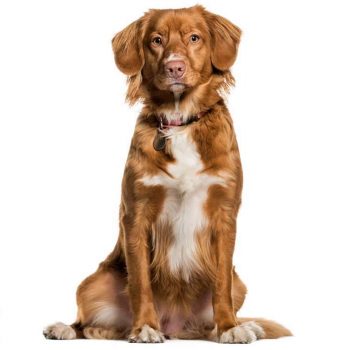Nova Scotia Duck Tolling Retriever
Group 3: Gun dogs
Height:
Male: 48 – 51 cm
Female: 45 – 48 cm
Energy Level: Low – Moderate
Original Function: Guardian
Lifespan: 8 – 10 yrs
Recommended for: Active people & families.

Group 3: Gun dogs
Height:
Male: 48 – 51 cm
Female: 45 – 48 cm
Energy Level: Low – Moderate
Original Function: Guardian
Lifespan: 8 – 10 yrs
Recommended for: Active people & families.

The Nova Scotia Duck Tolling Retriever is from Nova Scotia and they were bred to retrieve ducks from the icy waters, they excelled in swimming and retrieving. To toll means to lure and these dogs were encouraged to jump and play on the shoreline in hope that the inquisitive ducks would be lured into the fire range of the hunters.
They have wonderful temperaments and fit into family life fine, they are highly intelligent and easy to train.
Appearance: Medium-sized, powerful, compact, balanced, well-muscled dog; medium to heavy in bone, with a high degree of agility, alertness and determination. Many Tollers have a slightly sad expression until they go to work, when their aspect changes to intense concentration and excitement. At work, the dog has a speeding, rushing action, with the head carried out almost level with the back and heavily feathered tail in constant motion.
Temperament: Highly intelligent, easy to train & have great endurance. Loving & playful to their family, can be reserved with strangers, without being aggressive or overly shy. Aggression is not to be tolerated.
Characteristics: Strong & able swimmer, are a natural & tenacious retriever on land & from water. This strong retrieving desire & playfulness are qualities essential to their tolling ability.
Colour: Various shades of red or orange with lighter featherings and underside of tail, and usually at least one of the following white markings – tip of tail, feet (not exceeding beyond the pasterns), chest, and blaze.
Coat: The Toller was bred to retrieve from icy waters and must have a water-repellent, double coat of medium length and softness, with a softer, dense undercoat. The coat may have a slight wave on the back, but is otherwise straight. Some winter coats may form a long, loose curl at the throat.
Featherings are soft at the throat, behind the ears and at the back of the thighs, and forelegs are moderately feathered. While neatening of the ears and feet is permitted, the Toller should always appear natural.
Grooming: The thick coat needs regular brushing to keep it looking good. Wash when needed.
Exercise: plenty of exercise is needed to keep them fit and happy. Swimming is a great way to exercise them.
Health: